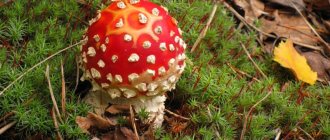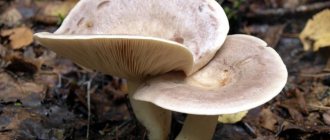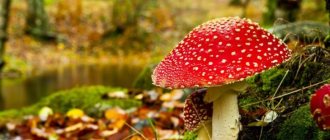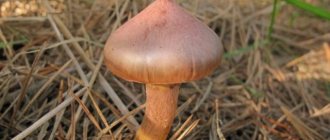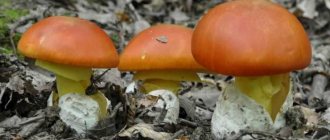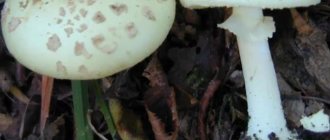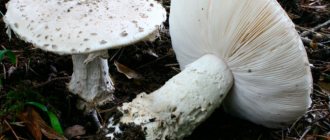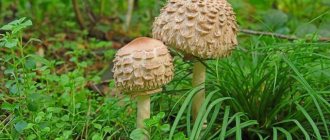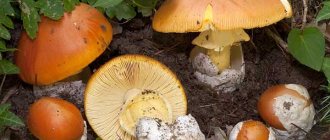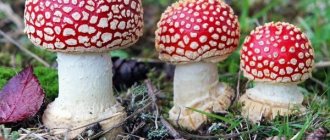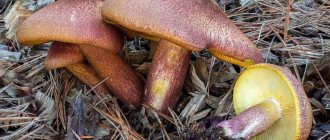Description and characteristics of edible mushroom
The gray-pink Amanita (Amanita rubescens) is also known as the blushing Amanita, the pearl Amanita or the pink Amanita. A member of the genus Amanita, it belongs to the family Amanitaceae.
The cap is small in diameter, ranging from 6 to 20 cm, dirty pink in color, covered with warty gray flakes. At first it is round or ovoid, but as it matures it becomes more prostrate. When it rains, mucus spots are noticeable on it.
Hymenophore is a part of the fruiting body containing hymenia (fungal spores) on its surface. In other words, this is the bottom part of the cap. In the fly agaric it is lamellar and turns red when it comes into contact with anything. The plates are white, wide, free. The spores are ellipsoidal in shape.
The leg does not exceed 20 cm. Cylindrical, hollow downwards. Tuberous, white or pink in color, has a tuberous thickening, filmy structure, hanging down on young mushrooms. As it ripens, it acquires a characteristic pink color and pronounced grooves. The thickening is subject to frequent attacks by insects, which lay larvae in it.
The structure of the fly agaric is fleshy and does not have a pronounced odor. The cut first acquires a pink tint, and over time becomes blood red.
IMPORTANT. Gray-pink fly agaric is safe and tasty, but the search should be entrusted only to experienced mushroom pickers!
The blushing fly agaric is not listed in the Red Book; its collection is limited only by personal taste preferences.
A little history
Elias Magnus Fries first described and assigned a binomial name to this species in 1821.
Similar species
The most dangerous thing is to confuse the gray-pink fly agaric with another representative of the genus Amonita, the panther fly agaric .
They are, indeed, very similar, and the main difference is that in the panther fly agaric, the flesh remains white when broken or cut; the same applies to other similar poisonous species of fly agaric.
The flesh on a break or cut in a gray-pink fly agaric always turns red! Moreover, this happens very quickly, after 20-30 seconds it turns pink, after 2 minutes it turns wine red.
Time and place of fruiting
This type of fly agaric prefers deciduous and coniferous forests, forming mycorrhiza with trees (a symbiosis of the roots of a plant and a fungus).
Unpretentious to soils, but loves temperate climates. Pearl fly agaric grows in small groups and is often found from mid-spring to late autumn.
The mushroom feels best in the temperate climate zone of the Northern Hemisphere. It can also be found in South Africa and almost throughout Russia.
ATTENTION. It is very important to be able to distinguish the pearl fly agaric from other species. The main distinguishing feature is the presence of redness of the flesh and stem at the site of damage.
Interesting facts about pearl fly agaric
- In many cultures around the world, the use of fly agarics (especially its hallucinogenic types) was considered a sacred act, allowing one to communicate with the spirits of ancestors or gods.
- Scandinavian berserker warriors (berserkers, bjersjorkers) before the battle used a decoction or tincture of hallucinogenic fly agaric mushrooms, which completely suppressed the feeling of fear and led to a state of battle rage.
- It is believed that red polka dot fabric appeared in the fashion industry thanks to fly agarics.
False doubles
Even if the mushroom is considered safe, you should remember about individual intolerance. It is also important to consider the area in which it grows.
| View | Morphology | Habitat | Main danger |
| Royal fly agaric (Amanita regalis) | The cap is from 7 to 16 cm, spherical in young mushrooms and almost flat in adults. The color is dark brown, olive-red, sometimes gray-yellow. The leg is thin, no more than 20 cm in length, with a noticeable spherical thickening at the bottom. The flesh of the mushroom is yellowish-white and does not have a specific odor. | Prefers moist coniferous forests of the European part of Russia. Representatives have also been found in Korea and Alaska. | It is a poisonous and highly toxic representative of the kingdom due to the content of muscimol, which causes damage to nerve endings. |
| Thick fly agaric, stocky fly agaric (Amanita excelsa) | The cap does not exceed a diameter of 12 cm, brown, silver-brown with light gray remains of the cover. The pulp has a faint turnip smell. | Easily tolerates drought and is widespread everywhere. | The mushroom is considered conditionally edible, however, due to its similarity with other representatives of fly agarics, which are very poisonous, collecting and consuming this species is not recommended. |
| Leopard or gray mushroom (Amanita pantherina) | It is almost identical in appearance to Amanita rubescens | Found in all types of forests in the Northern Hemisphere | Despite the fact that this mushroom is included in the Red Book of Russia, it is dangerous. It contains muscarine, muscaridine, hyoscyamine. Because of this composition, panther fly agaric is extremely toxic. Poisoning can be fatal. |
| Pale grebe (Amanita phalloides) | The cap rarely reaches 15 cm, mostly 10 cm. It has a silky skin, greenish-olive in color. As the mushroom ages, the cap acquires a flat-convex, prostrate shape. The leg is thin and does not exceed 20 cm, with greenish veins and widening at the bottom. | The pallid grebe prefers moist forests. It is difficult to find in dry areas. It is not picky about the type of soil and feels best in deciduous forests (it grows extremely rarely in coniferous forests). | Extremely dangerous. The body and leg contain a huge amount of phalloidin, which is a heavy toxin that affects parenchymal organs. |
The table shows photographs in which you can see that despite the obvious similarities, the doubles still have a number of differences from the pearl fly agaric.
REFERENCE. There are practically no insects in places where the gray fungus grows. Any insect will most likely die upon contact with its cap or stem.
Difference from the poisonous panther fly agaric
It is not so difficult to distinguish these two representatives of the genus from each other. Despite its almost identical appearance, the panther fly agaric never changes the color of the flesh when damaged (gray-pink always turns red).
Use
Pearl fly agaric.
Concerning the method of processing gray-pink fly agaric, disputes continue to this day. In some literature, it is considered edible and therefore, according to the authors, can be eaten fresh in all forms; other authors recommend boiling this mushroom for 20 minutes and only after that frying, boiling or stewing. The pearl fly agaric is also suitable for canning in pickled, salted or frozen form.
Amanita rubescens.
Evaluation of taste qualities, medicinal properties, benefits and possible harm
The taste of the pulp is vaguely reminiscent of chicken with a subtle taste of fly agaric, which cannot be accurately assessed.
The medicinal properties are due to the presence of betaine (a biologically active, vitamin-like substance) in the pulp. It is used as a biological additive and is included in medications designed to improve liver function.
Research is being conducted into the use of betaine for the treatment of Alzheimer's disease, cancer and as a weight loss aid.
Gray-pink fly agaric also contains rubescenslysin, which has hemolytic properties. Destroys the cell membranes of red blood cells; when administered intravenously, it causes death from hemorrhagic pulmonary edema. However, it is destroyed under the influence of high temperatures (above 80 ºС) and, once in the stomach, is not absorbed, and therefore does not cause harm.
Primary processing and cooking recipes
It is believed that the mushroom can be consumed raw, but it is mainly fried after preliminary boiling, and it is recommended to drain the first portions of water after boiling. Fly agaric is suitable for pickling and salting by any means. Dried fruit bodies are used to make soups and sauces.
Among other things, the mushroom can be frozen after cooking; it will retain all its properties for a year. When heat treatment, it is important to remember that there should be 3 times more water by volume than mushrooms. Using it as broth is strictly prohibited.
References
- Reed D. A., Eicher A. (1991). "South African mushrooms: genus Amanita
" (PDF).
Mycological studies
.
95
: 80–95. Doi:10.1016/S0953-7562 (09) 81364-6. Retrieved 2007-11-13. - Michael Kuo, Hypomyces hyalinus, MushroomExpert.com, October 2003
- "Archival copy." Archived from the original on 2006-12-07. Retrieved 2007-01-06.CS1 maint: archived copy as title (site link)
- Phillips, Roger (2010). Mushrooms and other fungi of North America
. Buffalo, NY: Firefly Books. n.. ISBN 978-1-55407-651-2.
Video gallery
Video reviews
A selection of videos with descriptions and recipes for preparing mushrooms
Irina Mazur, Mushrooms of Ukraine / Mushrooms of Ukraine, Mushroom Experts of the Russian Federation TV
external links
| Wikimedia Commons has media related to Amanita rubescens . |
- "Tabular and non-tabular keys to the ruddy Amanita
the Valida
section " Rodham E. Tulloss, March 10, 2003
Amanita rubescens
- "Amanita rubescens" Michael Kuo, MushroomExpert.Com
, March 2003 - "Amanita rubescens Pers.:Fr." Rodham E. Tulloss, June 25, 2006
Amanita novinupta
- "Amanita novinupta" Michael Kuo, MushroomExpert.Com
, March 2003 - "Amanita novinupta Tulloss & J. Lindgr." Rodham E. Tulloss, July 25, 2006
- "Amanita novinupta" by Michael Wood and Fred Stevens, MykoWeb
, 2004. And there will be
Fly agaric bright yellow
This type of mushroom is also poisonous. But, unlike the previous one, it is deadly in most cases. The color of the cap is characterized by a bright yellow color, it is also called lemon or orange-yellow. Its surface is covered with many snow-white flakes.
Under the cap there are plates that change color depending on the age of the mushroom. When the fly agaric is young, they are white, and when its life cycle reaches maturity, the plates acquire a brown tint. As for the pulp of the cap, its smell is very similar to the aroma of radishes.
The leg of the bright yellow fly agaric is characterized by fragility, velvety (but not always), and elongation. As the mushroom matures, the ring on it may completely disappear. Towards the base the leg takes on an expanded shape. This is precisely the main distinguishing feature of the poisonous fly agaric, which prevents it from being confused with the edible russula.
The fly agaric, described above, can be found from June to September.
Places where fly agarics grow in Vittadini.
This species is common in some southeastern and southern regions of Russia. These mushrooms grow in the protected steppes of Stavropol, Saratov region, Ukraine, Kyrgyzstan, and Armenia.
Vittadini fly agarics grow in European countries with a relatively warm climate: from Italy to the British Isles. These mushrooms are also found in Asia: in the Far East, Transcaucasia, Central Asia, Israel. The fly agaric Vittadini also lives in Africa, South and North America.
These mushrooms grow in steppes, forest-steppes, and near forest belts. In Southern Europe, this species is considered extremely rare, which may be why it is called poisonous. Fruiting of these fly agarics occurs from April to October. These fungi can settle on various soils.
Similarities between Vittadini fly agarics and other mushrooms.
The Vittadini fly agaric has an external resemblance to the white fly agaric, which is a deadly poisonous species.
The Vittadini fly agaric can also be confused with a white umbrella, but there is no danger in this.
Evaluation of the nutritional qualities of Vittadini fly agarics.
Young Vittadini fly agarics are considered edible. Their pulp has a pleasant smell and taste. But these are very rare mushrooms, so you should refrain from collecting them. In addition, there is a risk of confusing this conditionally edible mushroom with a deadly poisonous one.
Classification of fly agarics by Vittadini.
Some mycologists believe that the Vittadini fly agarics have features of both the genus Amanita and the genus Lepiota, and therefore they include these mushrooms in the genus Lepidella.
Advice from a healer: pros and cons
Many village healers, and just grandparents, believe that all sorts of tinctures of moonshine or vodka, ointments from fly agaric, even dry mushroom powder cure diseases and use all this themselves, although they often advise others as a panacea for almost all diseases at once .
After such “treatment” you will not only not recover, but with a high degree of probability you will acquire even more health problems.
It has already been said above that fly agaric is a mushroom that is particularly toxic and thanks to it, going “to the land of eternal hunting” is not at all difficult. It is especially dangerous for children, who need a much smaller dose of toxins to be lethal.
Even if it seems to you that using fly agaric infusion or ointment externally will not cause harm, this is not at all true.
Alcohol tincture
The toxins of this mushroom are not destroyed in alcohol, but their concentrate is excellent. And this is a real poison that will cause nothing but colossal harm to a person.
Only drugs prescribed by a doctor can be used for treatment according to a strict dosage regimen. So you shouldn’t self-medicate and go into the forest to collect fly agarics.
Sources
- https://palamos.ru/recepty/vidy-muhomorov-foto-i-opisanie.html
- https://organic-fertil.ru/griby/kak-vyglyadit-nastoyashchij-muhomor.html
- https://25school.ru/o-gribah/vidy-muhomorov-foto-i-opisanie.html
- https://muhomor.club/vidy/krasnyj
- https://gribnik.info/muhomor-krasnyj/
- https://nauka.club/okruzhayushchiy-mir/mukhomor.html
